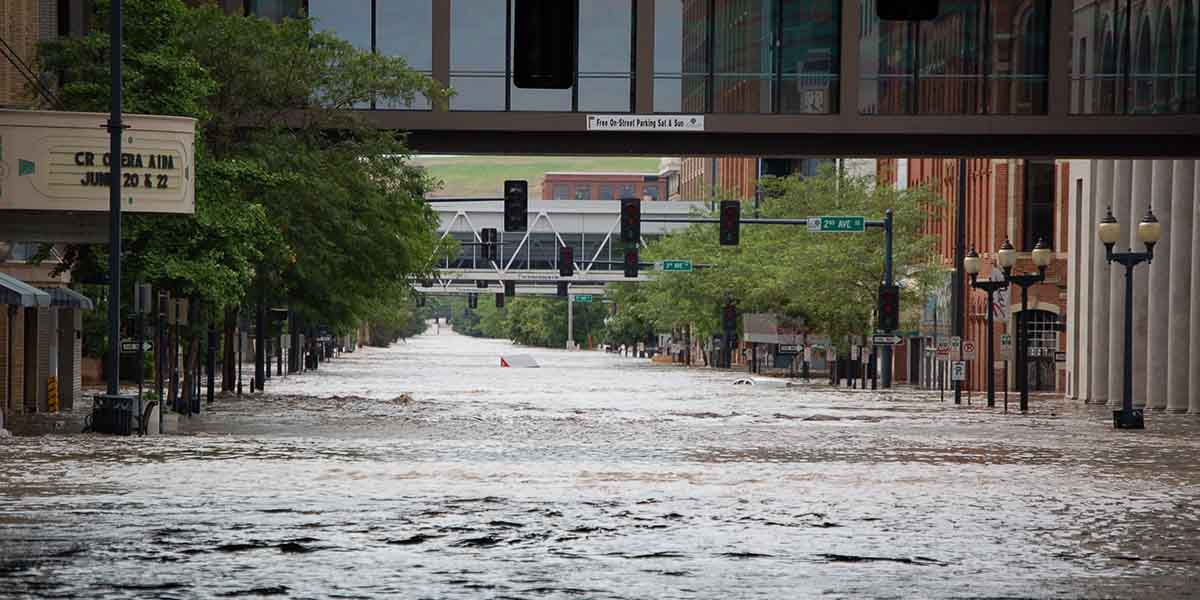Over 3 million people live in Iowa. Many of these people have experienced natural disasters in the state firsthand or had to evacuate because of disasters. However, many Iowa residents don’t realize just how many types of natural disasters can occur in the state.
This analysis covers what natural disasters occur in Iowa, the worst natural disasters to hit the state since 2000, and what residents can do to prepare.
Is Iowa At Risk of Natural Disasters?
Compared to the rest of the United States, Iowa has a low risk of natural disasters. Since 2000, Iowa has had 40 federal disaster declarations.
Iowa is also frequently hit by natural disasters, which caused more than $1 billion in damages. Since 2000, Iowa has been affected by 61 separate $1-billion events. Most of these were severe storms. Because Indiana is an agricultural state, droughts disasters are also particularly costly.
Worst Natural Disasters in Iowa By Cost (Since 2000)
- 2012 US Drought and Heat Wave: $40.2 billion
- 2022 Western/Central Drought and Heat Wave: $22.6 billion
- 2011 Southern Plains/SW Drought and Heat Wave: $16.5 billion
- Summer 2008 Midwest Flooding: $14.3 billion
- 2013 Western/Plains Drought and Heat Wave: $13.8 billion
Worst Natural Disasters in Iowa By Deaths (Since 2000)
- 2021 Western Drought and Heat Wave: 229 deaths
- 2000 Spring-Fall Heat Wave: 136 deaths
- 2012 US Drought and Heat Wave: 123 deaths
- 2011 Southern Plains/SW Drought and Heat Wave: 95 deaths
- 2022 Central and Eastern Winter Storm and Cold Wave: 87 deaths
*Cost and death tolls are for the entire disaster, including in other states affected.
Most Common Natural Disasters in Iowa
1. Flooding
Compared to the rest of the country, Iowa is high-risk for flooding. Floods often occur in Iowa because of heavy rainfall which causes the state’s many rivers to overflow. Approximately 12% of all properties in Iowa are at substantial risk of flooding.
Many big cities in Iowa, including Council Bluffs, Des Moines and Waterloo, have many properties at risk. Because of climate change, the risk of flooding is increasing in many areas of Iowa.
Iowa Flood Stats:
- 294,000 properties at substantial risk in 2020
- 9,328 properties at risk in Des Moines in 2020
- 120,300 FEMA flood damage claims since 2000
- 391,100 properties will be at risk by 2050
- 101,00 properties at almost certain risk by 2050
Which Areas of Iowa Are Most At-Risk to Flooding?
Every single area of Iowa has been hit by flooding. Some parts of the state have been hit more than a dozen times in the past few decades.
Below are the areas of Iowa with the greatest percentage of properties likely to experience flooding (based on 2020 calculations).
- Evansdale: 62%
- Clinton: 39%
- Decorah: 37%
- Council Bluffs: 37%
- Red Oak: 31%
- Camanche: 31%
- Waterloo: 30%
- Waverly: 28%
- Ottumwa: 24%
Worst Flood Events in Iowa’s Recent History
Throughout its history, Iowa has had many deadly and destructive floods. The worst flood event to hit the state recently was the June 2008 flood, sometimes called “Iowa’s Katrina.”
The flooding was caused by heavy rainfall in the previous year combined with heavy snowfall. When heavy rainfall occurred in the spring of 2008, the excess water caused the rivers in the eastern part of Iowa to flood. The Cedar and Iowa River basins were hit the hardest, but 85 of Iowa’s 99 counties were affected. Over 1,300 blocks in Cedar Rapids were flooded, 5,200 homes were affected, and thousands of properties in smaller towns.
The total damage from the flood exceeded $6 billion in property damage, and 2.3 million acres of cropland (10% of Iowa’s total) were destroyed.
2. Tornados
Iowa averages 52 tornadoes per year. While the state has never had an F5 tornado, it has had F4 tornadoes and many F3 tornadoes. These tornadoes can cause massive amounts of property damage.
Since 2000, there have been 22 tornado-related fatalities and over 330 injuries in the state. Because of how much damage they cause, Iowa ranks #7 in the USA in terms of tornado risk.
Also read:
3. Wildfires
As a Midwest state, Iowa is not high-risk for wildfires. The state does not get many wildfires per year. However, some of these fires can be very large and destructive.
In addition to causing property damage, wildfires can affect air quality. Because of climate change and increased temperatures, the risk of wildfires in Iowa is expected to grow. Residents should ensure they are prepared by having a Go Bag packed with an N95 respirator to protect their lungs.
Also read: How to Prepare for a Wildfire.
Iowa Wildfire Stats:
- Acres burned in 2021: 7,950
- Number of fires in 2021: 187
- Average fires per year: 218
- Average acres burned per year: 2,948
4. Heat Waves
Iowa is part of the “Extreme Heat Belt” in the central United States. This region is very at risk of what the National Weather Service calls “dangerous” and “extremely dangerous” heat days. A “dangerous” heat day is defined as one where the heat index is 103F and an “extremely dangerous” day has a heat index of 124F or above, which is considered unsafe for all people for any amount of time.
By 2053, Extreme Danger days will affect an estimated 107 million people in the Extreme Heat Belt. In Iowa, more than 70,000 are considered vulnerable to extreme heat.
Currently, Iowa only sees an average of less than 5 days per year with dangerous temperatures. However, this number is going to increase over the next few decades. By 2050, Iowa is expected to see nearly 40 dangerous heat days yearly.
The risk of dangerous heat days is expected to increase throughout Iowa. Van Buren is one of the most at-risk counties in the state. In 2020, Van Buren had 19 dangerous heat days. By 2053, this number will increase to 35 days.
5. Hail
The Southern part of Iowa is in “Hail Alley,” a region in North America that has a high amount of hail storms. While Iowa doesn’t get hit as hard as most other states in Hail Alley, it frequently has hail storms that cause damage. Each year, hail causes an estimated $63.73 of damage per capita in Iowa. Hail storms can occur during any time of year but are most common in spring months.
One of the worst hail storms in Iowa was the 2014 summer event in Adair. Hail balls shattered windows and damaged electricity lines, causing power outages. The event caused an estimated $10 million in damages.
6. Lightning
Iowa is one of the riskiest states when it comes to lightning strikes. In 2019 alone, there were over 3.6 million lightning strikes. When you factor in the size of the state, this makes Iowa one of the top 10 states for lightning strikes per square mile. From 1959 to 2016, there were 74 lightning deaths, making Iowa #17 in terms of lightning deaths in the country.
7. Winter Storms
Many cities in Iowa – including Des Moines, Waterloo and Sioux City — average more than 35 inches of snowfall per year. Severe snowstorms are common throughout the state.
These snowstorms are particularly dangerous for drivers. A 2018 snowstorm, for example, blanketed Iowa with 8 inches of snow and caused at least 9 vehicle-related deaths. When you factor in population size, Iowa is one of the deadliest states for winter driving.
Drastic changes in the weather can also occur, such as when the weather went from -17F in Cresco, Iowa, on February 13th, 2016, to 75F in Sidney, Iowa, on February 28th of the same year. This can make planning for winter weather difficult in Iowa.

















